Still selling older style Light Bulbs
Light and service life
In an incandescent lamp there is a direct physical link between the amount of light it emits and
the amount of time it will last. If more power is pumped into the filament, the filament will
emit more light but the life of the lamp will be drastically reduced because the higher temperatures will cause the filament material to evaporate more rapidly. The filament will therefore burn through sooner. Conversely, reducing the load on the filament in a conventional incandescent lamp will lead to longer life. OSRAM incandescent lamps are designed so that they achieve an average life of 1000 hours (as defined in the relevant standards). Statistically speaking, 50 percent of lamps will still be operational after 1000 hours. This applies of course only at rated voltage (e.g. 230V). If the
voltage is higher or lower than its rated value the life of the lamp will be shorter or longer accordingly.
The classic light bulb
The light from an incandescent lamp is produced with the aid of an electrical current that causes a fine wire to glow. Around five percent of the electrical energy is converted into light.
The rest is given off to the environment as heat.
Light bulbs - more than 100 years of success.
The German clock- maker Johann Heinrich Goebel invented the incandescent lamp in 1854.
Thomas Edison then developed the concept and turned it into a useable product in 1879.
For many years artificial light hung by a delicate thread - a carbon thread in fact. OSRAM
replaced this carbon thread with a much stronger metal filament.
Since then, lamps have undergone a process of continual improvement, new ways of generating
light have been invented and new materials have been used. Recent innovations have been
made with two main objectives in mind, namely improved economy and environmental
compatibility.
The ordinary light bulb is still the most popular light source. Its warm light creates a pleasant
atmosphere. The light bulb is still the number one choice for general lighting.











